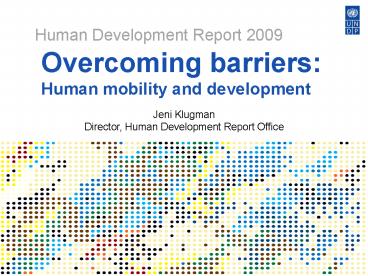Overcoming barriers: Human mobility and development - PowerPoint PPT Presentation
1 / 14
Title:
Overcoming barriers: Human mobility and development
Description:
Of the nearly 1 billion movers in the world, 740 million are internal migrants. Among international movers, only 2/5 move from developing to developed countries. ... – PowerPoint PPT presentation
Number of Views:25
Avg rating:3.0/5.0
Title: Overcoming barriers: Human mobility and development
1
Overcoming barriers Human mobility and
development
- Human Development Report 2009
Jeni Klugman Director, Human Development Report
Office
2
Origins and Evolution
- Launched in 1990, the Global HDR has gained
prominence and widespread use. - Since then, annual global reports, on a diversity
of themes gt 2009 Human mobility and development
3
Human movement in an unequal world
- The world distribution of opportunities is
extremely unequal. - Someone born in Thailand can expect to live 7
more years, to have almost 3 times as many years
of education, and to spend and save 8 times as
much as someone born in Myanmar. - This type of inequality is a key driver of human
movement. - The lowest HDI in a US border county is above
even the highest on the Mexican side.
4
Who moves where, when and why
- Focus is often on S-N movement, and OECD
destinations eg Dustmann -- BUT - Most movement in the world does not take place
between developing and developed countries, or
even between countries. - Most people who move do so within the borders of
their own country. - Of the nearly 1 billion movers in the world, 740
million are internal migrants. - Among international movers, only 2/5 move from
developing to developed countries.
5
Barriers matter
- Despite demographic pressures and growing income
inequality, the share of the worlds population
moving has not increased since 1960. - However, the direction of their movement has
changed more go to developed countries than in
the past. - Overly restrictive barriers to entry prevent many
people from moving under regular channels.
6
Recessions and migrant unemployment (1)
- In a panel of 14 EU economies, we found that
unemployment rates for migrants go up much faster
than those of local during recessions. - This confirms Dustmann et al.s UK and Germany
results using macro data. - 1 ? GDP ? 4.2 ? in immigrant local
unemployment ratio - However, our results also showed that this
phenomenon only characterizes recessions, and not
the normal fluctuations of stable economies. - Hence patterns during the recession are not
necessarily appropriate for thinking about
long-run trends.
7
Impacts of the crisis (2)
8
But beyond the crisis clear underlying trends
- However, as the recovery ensues, underlying
long-run trends will dominate. - -gt demographic ageing and shrinking populations
in developed countries, growing and youthful
populations in developing countries. - and imply continuing pressures for and
benefits from international migration.
9
Policy implications? ?key pillars
- 1. Liberalize and simplify regular channels that
allow people with low skills to seek work abroad - 2. Ensure basic rights for migrants
- 3. Reduce transactions costs associated with
migration - 4. Improve outcomes for migrants and destination
communities - 5. Enable benefits from internal mobility
- 6. Make mobility an integral part of human
development strategies
10
Expanded access design is key
- Two mechanisms
- Expand schemes for seasonal work (New Zealand)
- Expand visas conditional on employer demand
(Sweden) - Process must consider views of unions, employers
and technical advice. - Pathways to permanence and provisions to
facilitate circularity are vital. - Earned regularizations as a good way to deal
with irregularity.
11
Ensuring basic rights
- Few states have ratified conventions seeking to
ensure migrants rights. - Yet existing protocols have strong
anti-discrimination clauses, not limited to
citizens - Observance of core human rights treaties would
yield greater protection to migrants.
12
Improving outcomes
- Provide access to basic servicesparticularly
schooling and health care - Help newcomers acquire language proficiency
- Facilitate access to the labour market, e.g.
allowing people to move among employers - Support local government eg fiscal transfers to
finance additional local needs
13
Can this be done?
- Despite perceived opposition towards migration
also noted by Dustman - deeper analysis reveals
important facts - Most people favor immigration when jobs are
available. - Most people support allowing migrants to stay
permanently rather than temporarily. - Opposition to migration is often shaped by
misperception of its consequences. - Policy design can address these concerns
- Number of entrants responsive to labor demand,
need to ensure observance of national and local
labor standards, and emphasis on improving
treatment and respecting rights.
14
Overcoming barriers
- In sum Dustmans analysis casts important light
about efficiency and distribution effects,
especially via the labour market, BUT - Need to think beyond the crisis
- Consider impacts beyond income, and beyond
wealthy destination places - Develop politically feasible reforms that are
oriented towards helping those who are most
disadvantaged and have the most to gain - Call for bold and committed leadership to make a
huge difference to the lives of many millions































